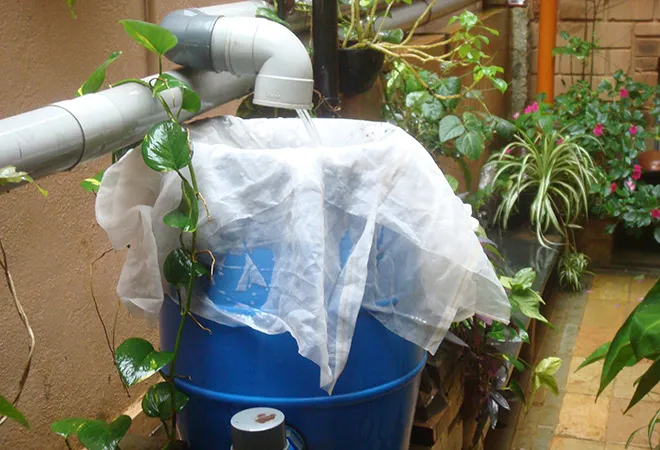
In India, millions of people live in cities, and the demand for water is huge. City governments through their water supply arrangements are meeting most of the demand, however, several areas in cities still remain uncovered by government services. Moreover, continuous supply of piped water round the clock is not available. There are many reasons for the occurrence of such problems, including availability of less water with city governments for distribution to consumers, and inefficiencies in water management. Thus, city governments are working towards overall improvement of the urban water supply sector, and are making greater efforts to arrange more water from different sources, such as rivers, lakes, canals, rainfall, and groundwater.
Seasonal precipitation or rainfall has been a useful and good source of water. Rains occur over large parts of the Indian sub-continent, and there has been a practise of collecting and utilising rainwater for various purposes. This method, popularly known as rainwater harvesting (RWH), ensures availability of water for future use. In places where adequate surface/ground water is not available with the water supply agency, the establishment of proper RWH systems has helped in meeting the water requirements of communities.
Considering the benefits, many city governments in India are making efforts to popularise and implement this method, and progress is seen in the form of RWH systems installed in government and private buildings, houses and housing societies, institutions, and in public places. For example, at the international airport in Delhi, over 300 wells have been built to collect rain water for recharging groundwater/aquifers. As water consumption at the airport is extremely high (about 4.5 mld), practises of RWH and water recycling help airport authorities in meeting the demand, and thus reduce dependence on the city’s already overburdened water supply agency.
Despite increasing awareness, and government push by way of legislative, planning, and physical interventions, such as linking RWH systems with occupancy certificates of new buildings, and the proposal on establishing cells to monitor RWH in all towns and cities of the country, the growth of RWH sector has been slow, and only 8 percent of the country’s rainwater is being collected. While there are many reasons for the slow progress, this article focuses on the practical problems with RWH systems. These are briefly described below. In this regard, the author argues that such problems are coming in the way of wider acceptability and implementation of RWH systems particularly in buildings, and these must be solved for greater utilisation of rainwater for both potable and non-potable purposes.
Rainwater quality: Although rainwater is relatively clean, there are chances of contamination if the atmosphere is polluted, or when rainwater is not collected or stored properly. In this regard, multiple problems can occur. The COVID-19 period is an exception when everything has come to a standstill due to the lockdown. Otherwise, Indian cities have been recording very high levels of air pollution, and there is every possibility of its negative impact on rainwater. Similarly, rooftops of buildings and catchment areas (such as pits on vacant lands) are exposed to dust, bird and animal droppings, insects and garbage. If these impurities are not prevented from entering the drain pipes, storage tanks, or pits, the water quality will deteriorate, and the tanks/pits will also be filled with sediments. The other problem is the presence of zinc and lead in the stored rainwater, caused by leaching from metal roofs/pipes/tanks. If water with such impurities is utilised for drinking (or potable) purposes, there can be serious health problems. WHO points out that “higher microbial concentrations are generally found in the first flush of rainwater, and the level of contamination reduces as the rain continues; uncovered storage tanks on the other hand are ideal places for breeding of mosquitoes.” Therefore, RWH systems should be designed, installed and maintained in a manner that catchments, drains/gutters, and storage tanks remain free from any form of impurities. In this regard, the following suggestions are available in literature:
- regular checking of water quality, disinfection with chlorine to kill algae, bacteria and viruses, and cleaning of catchments and tanks to remove sediments;
- use of non-toxic materials (such as concrete tanks, instead of plastic or metal tanks) in catchments and tanks to prevent leaching and maintaining healthy standards of acidity in rainwater (i.e., pH value of 7);
- placement of wire meshes/filters over entry points of pipes/gutters to prevent leaves and insects from entering storage tanks;
- placement of covers and meshes over storages and openings to prevent mosquito breeding;
- Installing a downpipe diverter for diverting the first flush of dirty rainwater into an alternate water chamber, as well as for blocking contaminated water from entering the tank;
Mineral content of rainwater: People require several minerals and vitamins to maintain good health. These are available in drinking water, food, and sunlight. It is found that there is deficiency of minerals, such as calcium and magnesium, in rainwater, and that absence of these affect the taste of water. Drinking rainwater without remineralisation is also harmful for the human body. Therefore, to make rainwater drinkable, it is necessary to add essential minerals. Nowadays, bio-mineral cartridges packed with many minerals and trace elements are available in some countries for increasing minerals in rainwater. These cartridges can be installed in storage tanks.
Size of rainwater storage tanks: There is uncertainty over the quantum of rainwater received before rain occurs. Thus, it is important to ensure that tanks are of a size that is able to store larger quantities of water for future use, especially during the dry season when the demand is extremely high. The size of tank to be built can be roughly determined by estimating the RWH potential of an area. Another issue experienced with regard to the size is overflowing of tanks due to excess rainwater received. This issue can be addressed by installing a good rainwater diverter that will prevent the tank from overflowing. In this arrangement, any excess water received is diverted for use in gardens, or other non-potable purposes.
To ensure that the above-mentioned problems do not arise, specialised companies recommend up to eight steps for successful RWH, i.e., limit sources of contamination, plan for storage volume, filter leaves and debris, divert the first flush of rainwater, secure tanks with screens and covers and install an air gap to prevent storm water backflow, manage standing water in tanks, use a filter to reduce sediment, and monitor water level (in tanks) and its usage.
A review of information on common problems with RWH systems reveals that these are broadly related to three aspects - rainwater quality, mineral content of rainwater, and size of storage tank. To overcome these, proper arrangements are required in the three main components of the system for ensuring maximum water quality and volume harvested. Any deficiency in this regard would lead to the system being dysfunctional, or utilised below its capacity. Further, a deficient system poses health risks for the consumers if the water is used for drinking, bathing or washing utensils. There is evidence to show that adequate attention is not being paid in this regard in many cities of India and condition of installed systems is deteriorating. Many have been abandoned, and the money spent on laying down the RWH infrastructure has gone to waste.
City residents, especially the poor communities, are in dire need of more water, and RWH can significantly contribute towards meeting this essential requirement. For a wider expansion and installation of proper RWH systems, it will be beneficial for city governments to:
- Generate greater awareness among citizens on environmental and economic benefits of RWH;
- Conduct regular meetings with resident associations to answer various queries on RWH;
- Collaborate with specialised private agencies that offer the best advice and cost-effective technological solutions;
- Ensure that private agencies make all arrangements at the time of laying down the RWH infrastructure for ensuring clean water availability;
- Assign work of monitoring the established RWH systems to independent agencies;
- Ensure that RWH systems are installed on rooftops in high population density areas, such as high rise apartments, housing societies, institutional and commercial areas;
- Ensure that RWH systems are installed on public land near unauthorised colonies and slums;
- Maintain a list of all RWH systems installed in the city along with their location and condition.
The views expressed above belong to the author(s). ORF research and analyses now available on Telegram! Click here to access our curated content — blogs, longforms and interviews.




 PREV
PREV


